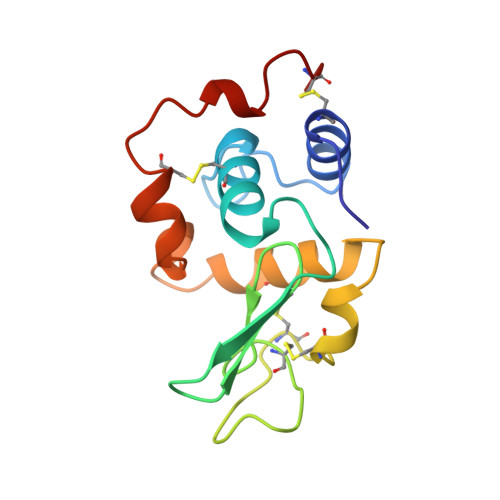Contribution of the hydrophobic effect to the stability of human lysozyme: calorimetric studies and X-ray structural analyses of the nine valine to alanine mutants.
Takano, K., Yamagata, Y., Fujii, S., Yutani, K.(1997) Biochemistry 36: 688-698
- PubMed: 9020766
- DOI: https://doi.org/10.1021/bi9621829
- Primary Citation of Related Structures:
1OUB, 1OUC, 1OUD, 1OUE, 1OUF, 1OUG, 1OUH, 1OUI, 1OUJ - PubMed Abstract:
To clarify the contribution of the hydrophobic effect to the conformational stability of human lysozyme, a series of Val to Ala mutants were constructed. The thermodynamic parameters for the denaturation of these nine mutant proteins were determined using differential scanning calorimetry (DSC), and the crystal structures were solved at high resolution. The denaturation Gibbs energy (delta delta G) and enthalpy (delta delta H) values of the mutant proteins ranged from +2.2 to- 6.3 kJ/mol and from +7 to -17 kJ/mol, respectively. The structural analyses showed that the mutation site and/or the residues around it in some proteins shifted toward the created cavity, and the substitutions affected not only the mutations site but also other parts far from the site, although the structural changes were not as great. Correlation between the changes in the thermodynamic parameters and the structural features of mutant proteins was examined, including the five Ile to Val mutant human lysozymes [Takano et al. (1995) J. Mol. Biol. 254, 62-76]. There was no simple general correlation between delta delta G and the changes in hydrophobic surface area exposed upon denaturation (delta delta ASAHP). We found only a new correlation between the delta delta G and delta delta ASAHP of all of the hydrophobic residues if the effect of the secondary structure propensity was taken into account.
Organizational Affiliation:
Institute for Protein Research, Osaka University, Japan.















